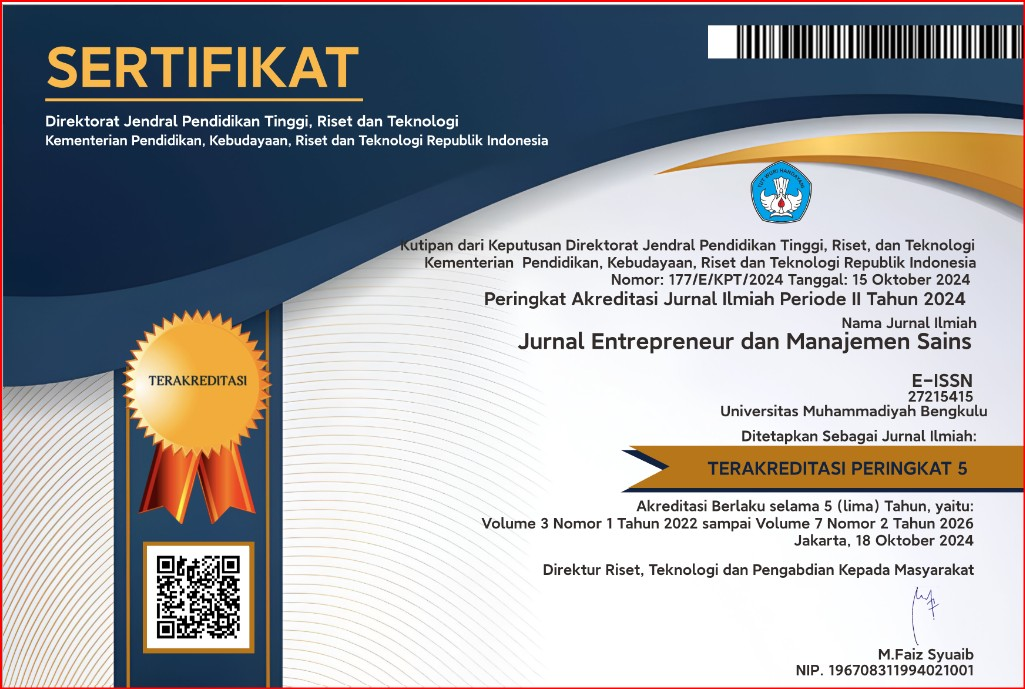PENGRAUH WORK LIFE BALANCE DAN LINGKUNGAN KERJA NON FISIK TERHDAP KEPUASAN KERJA KARYAWAN (Studi Kasus Pada PT. Agrecinal Bengkulu Utara)
DOI:
https://doi.org/10.36085/jems.v4i2.5550Abstract
This study aims to determine the influence of Work Life Balance and Non-Physical Work Environment on Employee Job Satisfaction. This research uses quantitative research methods. With the population in this study are field employees of PT. North Bengkulu Agricinal, with the sampling method using the Purposive Sampling method in conducting the research the respondents were obtained randomly, totaling 112 people. In this study using data collection methods by way of observation, interviews and distributing questionnaires or questionnaires. The data that has been collected is then processed using an instrument test, analysis of respondents' responses, classic assumption test, multiple linear regression analysis, coefficient of determination (R2) and hypothesis testing using SPSS 25
Based on the results of multiple linear regression, the formulation Y = 3.877 + 0.863X1 + 0.279X2 Coefficient of determination R2 = 0.639 or 63.9% while the remaining 0.361 or 36.1% is influenced by other variables outside the research. work-life balance (X1) obtained that the value of t count for tcount > ttable (9.896 > 1.659) with a significance of 0.000 <0.05. the work environment variable (X2) is 4.961, this means tcount > ttable (4.961 > 1.659) with a significance of 0.000 <0.05. From the results of data processing, it can be concluded that work-life balance and non-physical work environment partially or simultaneously have a positive and significant effect on job satisfaction
Keywords: work-life balance, non-physical work environment, job satisfaction
References
Andriani, C., & Onsardi, O. (2020). Pengaruh Kompensasi, Pelatihan Kerja Dan Kepuasan Kerja Terhadap Kinerja Karyawan Marketing. (Jems) Jurnal Entrepreneur Dan Manajemen Sains, 1(2).
Aruan, Q. S., & Fakhri, M. (2015). Pengaruh Lingkungan Kerja Terhadap Kepuasan Kerja Karyawan Lapangan Departemen Grasberg Power Distribution Pt. Freeport Indonesia. Modus, 27(2), 141–162.
Asepta, U. Y., & Maruno, S. H. P. (2017). Pengaruh Work-Life Balance Pengembangan Karir Terhadap Kepuasan Kerja. Jurnal JIBEKA, 11(1), 77–85.
Effendi. (2013). Telaah Kualitas Air Bagi Pengolahan Sumber Daya dan Lingkungan Perairan. Kanisius.
Ghozali, I. (2013). Aplikasi Analisis Multivariate dengan Program IBM SPSS 21 Update PLS Regresi. Badan Penerbit Universitas Diponegoro.
Hasibuan, M. S. (2005). Manajemen SDM. Edisi Revisi, Cetakan Ke Tujuh. Bumi Aksara.
Hudson. (2005). The Case For Work Life Balance : Closing The Gap Between Policy And Practice. Hudson Highland Group, Inc.
Juliandi, Azuar, I., & Manurung, S. (2015). Metodologi Penelitian Bisnis (kedua). UMSU PRESS.
Kasmir. (2016). Analisis Laporan Keuangan. Raja Grafindo Persada.
Kasmir. (2016). Manajemen Sumber Daya Manusia (Teori dan Praktik). PT Rajagrafindo Persada.
Kaswan. (2012). Manajemen Sumber Daya Manusia untuk Keunggulan Bersaing Organisasi. Graha Ilmu.
Komara, E. (2018). Penguatan Pendidikan Karakter dan Pembelajaran Abad 21. Sipatahoenan: South-East Asian Journal for Youth, Sports & Health Education, 4(1), 17–26.
Lewison, J. (2006). The work/life balance sheet so far. Journal of Accountancy, 202(2).
Lumunon, R. R., & Sendow, G. M. (2019). Pengaruh Work Life Balance, Kesehatan Kerja Dan Beban Kerja Terhadap Kepuasan Kerja Karyawan Pt. Tirta Investama (Danone) Aqua Airmadidi the Influence of Work Life Balance, Occupational Health and Workload on Employee Job Satisfaction Pt. Tirta Investama . Jurnal EMBA, 7(4), 4671–4680.
Nitisemito. (2012). Manajemen Suatu Dasar dan Pengantar, Arena, Ilmu. McDonald, P. Bradley, L. and Brown, K. 2005. Explanations for The Provision Utilization Gap in Work-Family Policy. Women in Management Review (in press).
Onsardi, O., & Finthariasari, M. (2022). Manajemen Sumber Daya Manusia (Strategi Meningkatkan Kinerja Karyawan).
P, H. (2012). Work Life Balance. IEEE-USA.
Robbins, S. P., & Coulter, M. K. (2010). Management. Erlangga.
Rodhiyatu Aliya, G., & Saragih, R. (2020). Pengaruh Work-Life Balance dan Lingkungan Kerja Terhadap Kepuasan Kerja Karyawan Di PT Telkom Divisi Telkom Regional III Jawa Barat. Jurnal Ilmiah MEA (Manajemen, Ekonomi, & Akuntansi), 4(3), 84–95.
Schermerhorn. (2005). Management 8th ed. John Wiley & Sons.
Sedarmayanti. (2017). Manajemen Sumber Daya Manusia. PT Refika Aditama.
Simamora, H. (2012). Manajemen Sumber Daya Manusia. STIE YKPN Yogyakarta.
Sitinjak, L. . (2018). Pengaruh Lingkungan Kerja Terhadap Kepuasan Kerja Karyawan (Studi pada Karyawan PT. Mitra Pinasthika Mustika Rent Tangerang Selatan). Jurnal Administrasi Bisnis (JAB), 60(2), 162.
Soegianto, A. (2012). Ilmu Lingkungan, Sarana Menuju Masyarakat Berkelanjutan. Airlangga University Press.
Sugiyono. (2013). Metode Penelitian Kuantitatif, Kualitatif dan R&D. Alfabeta.
Sugiyono. (2014). Metode Penelitian Pendidikan Pendekatan Kuantitatif, Kualitatif, dan R&D. Alfabeta.
Sunyoto, D. (2015). Manajemen dan Pengembangan Sumber Daya Manusia (Cetakan Pertama). CAPS (Center for Academic Publishing Service).
Sutrisno, E. (2014). Manajemen Sumber Daya Manusia. Pranada Media Group.
Utami, D.S. & Yuniarti, K. W. (2010). To Be Istiqama’: Harmonizing Work, Family, Society and Leisure (A Case Study among Muslim Women Lecturer in Yogyakarta). Book of Abstracts of The 1st International Conference of Cross Cultural and Indigenous Psychology (ICICP), Yogyakarta, Indonesia.Jurnal Vol.2010
Wandy, Z., & Yayan, S. (2017). Pengaruh kepuasan kerja dan komitmen organisasi terhadap keinginan berpindah karyawan PT. Delami Garmen Kota Bandung. Jurnal Akuntansi, Ekonomi Dan Manajemen Bisnis, 5(1), 105.
Wibowo. (2014). Perilaku Dalam Organisasi (Edisi 1-2). Rajawali Pers.
Wursanto, I. (2016). Kompetensi Sekretaris Profesional. Andi.
Downloads
Published
Issue
Section
License

This work is licensed under a Creative Commons Attribution-NonCommercial-NoDerivatives 4.0 International License.







